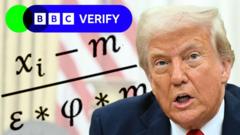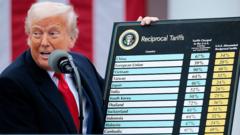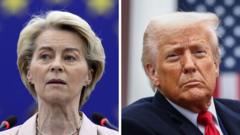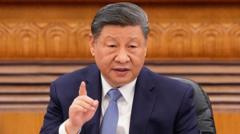A closer examination shows that these tariffs are aimed at addressing trade deficits rather than being truly reciprocal.
**Understanding the Calculation of Trump’s Tariffs on Imports**

**Understanding the Calculation of Trump’s Tariffs on Imports**
The methodology behind the 10% tariffs imposed by the Trump administration reveals a straightforward mathematical formula.
In recent developments, President Donald Trump's administration has enacted a 10% tariff on most imported goods, escalating rates for nations deemed "worst offenders." The calculation of these tariffs has raised questions, prompting BBC Verify to delve into their methodology. Initially, the tariffs appeared to be a mix of existing tariffs and other trade barriers; however, the White House later revealed a seemingly complex formula that reduces to simple math.
To calculate the relevant tariff on imports from a specific country, the process is straightforward: take the trade deficit with that country, divide it by the total goods imported from that nation, and then split that number in half. A trade deficit indicates that the US imports more from a country than it exports to them. For instance, with China, the US faces a goods deficit of $295 billion and imports a total of $440 billion in goods. Dividing 295 by 440 yields approximately 67%, which, when halved, results in a tariff of 34%.
A similar calculation for the European Union led to a 20% tariff, demonstrating a lack of reciprocity. While one might expect tariffs to reflect what other countries impose on US goods plus existing non-tariff barriers, Trump’s administration did not apply this reasoning consistently. The tariffs were specifically derived from the goal of eliminating trade deficits, even with nations like the UK, where the US maintains a trade surplus.
Trump has long asserted that the US is being disadvantaged in global trade, arguing that foreign countries flood the US market with affordable products while imposing barriers that undermine American competitiveness. His strategy, therefore, focuses on using tariffs as a tool to revive domestic manufacturing and safeguard jobs.
However, experts caution that these tariffs may address bilateral trade deficits without affecting the broader overall deficit that the US holds with the global market. Economists suggest that while the tariffs may shift trade balances between the US and individual countries, they may not rectify the underlying structural economic issues contributing to the US's continued trade deficit. As such, many believe this approach lacks sound economic rationale and could impose significant costs on the global economy.
Overall, while the tariffs seem to showcase a tactical shift in trade policy, their effectiveness in achieving the intended results remains to be seen against the backdrop of complex global economic dynamics.
To calculate the relevant tariff on imports from a specific country, the process is straightforward: take the trade deficit with that country, divide it by the total goods imported from that nation, and then split that number in half. A trade deficit indicates that the US imports more from a country than it exports to them. For instance, with China, the US faces a goods deficit of $295 billion and imports a total of $440 billion in goods. Dividing 295 by 440 yields approximately 67%, which, when halved, results in a tariff of 34%.
A similar calculation for the European Union led to a 20% tariff, demonstrating a lack of reciprocity. While one might expect tariffs to reflect what other countries impose on US goods plus existing non-tariff barriers, Trump’s administration did not apply this reasoning consistently. The tariffs were specifically derived from the goal of eliminating trade deficits, even with nations like the UK, where the US maintains a trade surplus.
Trump has long asserted that the US is being disadvantaged in global trade, arguing that foreign countries flood the US market with affordable products while imposing barriers that undermine American competitiveness. His strategy, therefore, focuses on using tariffs as a tool to revive domestic manufacturing and safeguard jobs.
However, experts caution that these tariffs may address bilateral trade deficits without affecting the broader overall deficit that the US holds with the global market. Economists suggest that while the tariffs may shift trade balances between the US and individual countries, they may not rectify the underlying structural economic issues contributing to the US's continued trade deficit. As such, many believe this approach lacks sound economic rationale and could impose significant costs on the global economy.
Overall, while the tariffs seem to showcase a tactical shift in trade policy, their effectiveness in achieving the intended results remains to be seen against the backdrop of complex global economic dynamics.





















